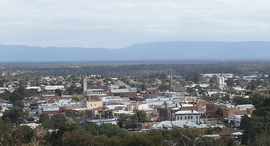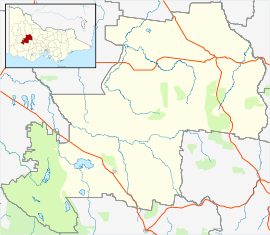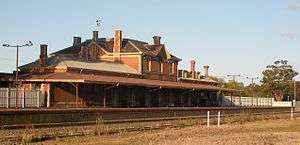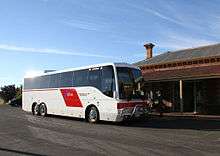Stawell, Victoria
Stawell (pronounced /stɔːl/, "Stawl"), is an Australian town in the Wimmera region of Victoria 237 kilometres (147 mi) west-north-west of the state capital, Melbourne. Located within the Shire of Northern Grampians local government area, it is a seat of local government for the shire and its main administrative centre. At the 2016 census, Stawell had a population of 6,032.[1]
| Stawell Victoria | |||||||||
|---|---|---|---|---|---|---|---|---|---|
 View south over Stawell toward the Grampians National Park from Big Hill lookout | |||||||||
Main street, Stawell | |||||||||
 Stawell | |||||||||
| Coordinates | 37°03′0″S 142°46′0″E | ||||||||
| Population | 6,032 (2016 census)[1] | ||||||||
| Established | 1853 | ||||||||
| Postcode(s) | 3380 | ||||||||
| Elevation | 231 m (758 ft) | ||||||||
| Location | |||||||||
| LGA(s) | Shire of Northern Grampians | ||||||||
| County | Borung | ||||||||
| State electorate(s) | Ripon | ||||||||
| Federal Division(s) | Wannon | ||||||||
| |||||||||
It was founded in 1853 as Pleasant Creek during the Victorian gold rush. It is one of few towns in Victoria retaining an active gold mining industry.
Stawell is famed for the Stawell Gift, a professional foot race that began in 1878. It is also known as the gateway to the Grampians National Park. One of the most significant Aboriginal cultural sites in south-eastern Australia is Bunjil's Shelter, within the Black Range Scenic Reserve, south of Stawell.
It is named after Sir William Foster Stawell (1815–89), the Chief Justice of Victoria.
History
Aboriginal peoples of Victoria lived in the Stawell area for many thousands of years before the colonisation of Australia. The formally recognised traditional owners for the area north-east of the Horsham and Ararat roads, are the Wotjobaluk, Jardwadjali (also known as Jaadwa), Wergaia and Jupagalk nations.[2] These nations are represented by the Barengi Gadjin Land Council Aboriginal Corporation.[3] In the area of Stawell that is south-west of Horsham and Ararat roads traditional owners have not yet been formally recognised; however, the Eastern Maar Aboriginal Corporation (EMAC) is negotiating a recognition and settlement agreement with the Victorian Government. The boundary of the agreement is under negotiation.[2][4] The Eastern Maar people are represented by the Eastern Maar Aboriginal Corporation.[5]
William McLachlan discovered alluvial gold at Pleasant Creek in May 1853, but the yield was not in sufficient volumes to attract much interest, as the Ballarat and Bendigo fields were known to be giving better results, and had already established the infrastructure to support the miners. There was however sufficient numbers for the area to support the beginnings of a settlement. The town site was first settled during 1853 and was named Pleasant Creek. The mining population of the Stawell field remained relatively small (averaging 200 or less) until 1857 when a series of new alluvial gold discoveries were made.[6]
In August 1857 more extensive prospecting and mining occurred at what became known as Commercial Street, Pleasant Creek.[7]
Two Post Offices were opened, Pleasant Creek on 19 October 1857 and Quartz Reef, Pleasant Creek on 1 June 1859. In 1858 diggers opened the Great Western goldfield, which was worked by some 9,000 prospecters.[6] The prospecting spread to nearby Deep Lead, about 6 kilometres to northwest, and it was reported that at the height of the rush there were over 25,000 people in the area. At the same time, shafts were being sunk around Big Hill, becoming known as the Quartz Reefs. Much alluvial gold was found in the area but the 'fossicking' petered out by 1859.[7]
In 1861, the township was renamed to honour Sir William Stawell (1815–89), the Chief Justice of Victoria resulting in the name of the Pleasant Creek post office becoming "Stawell". The town was created a borough in 1869.[8]
In 1870 Stawell post office was renamed Stawell West, and Quartz Reef, Stawell post office was renamed to Stawell.[9] Stawell Town Hall was constructed in 1872, under the guidance of Stawell Shire Engineer, John D'Alton.
The former Free Library and Mechanics Institute building at 170 Main Street was constructed in 1874 to the design of Stawell architect, George Inskip. The building has served as the location of the Mechanics Institute, School of Design (later School of Mines) and the Borough Library. It is now the headquarters of Australian Regional Education.
The town's water supply system was designed by John D'Alton in 1875, diverting water from Fyan's Creek by tunnels and pipelines, construction was completed in 1881.[10]
By the mid-1920s the gold mining had effectively ceased as the yields were found to be no longer commercially viable.[7] A Pioneer's memorial was erected on Big Hill in 1938.
The town hall underwent significant postwar remodelling, culminating in the addition of the landmark clock tower in 1939.
The Quartz Gold Memorial and Dane Memorial seat were erected on Big Hill in 1953 out of local quartz stone.
Stawell's historical association with gold-mining was revived when full-scale mining recommenced in 1981.[11]
Demographics
As of the 2016 census, 6,032 people resided in Stawell. The median age of persons in Stawell was 47 years.[1] Children aged 0–14 years made up 14.8% of the population. <[1] People over the age of 65 years made up 25.0% of the population.[1] There were slightly more females than males with 51.6% of the population female and 48.4% male.[1] The average household size is 2.2 people per household.[1] The average number of children per family for families with children is 1.8.[1]
84.2% of people in Stawell were born in Australia.[1] Of all persons living in Stawell, 1.8% (19 persons) were Aboriginal and/or Torres Strait Islander people.[1] This is higher than for the state of Victoria (0.8%) and lower than the national average (2.8%).[1] The most common ancestries in Stawell were English 33.4%, Australian 33.1%, Scottish 7.8%, Irish 7.4% and German 3.9%.[1]
Governance

Stawell is a seat of local government for the Northern Grampians Shire (the other being St Arnaud). The council meets regularly at Council Chambers at the Shire's offices on the Western Highway. Stawell is also the main administrative centre for the council, with its customer service administration facility located at the Stawell Town Hall. The LGA was created in 1994 as an amalgamation of a number of other municipalities in the region and currently consists of 4 wards, each represented by one to three councillors elected once every four years by postal voting.[12]
In state politics, Stawell is located in the Legislative Assembly electoral district of Ripon, currently held by Louise Staley (Liberal Party). Stawell is located within the Victorian Legislative Council's Western Victoria Region.
In federal politics, Stawell is located in a single House of Representatives division—the Division of Wannon.
Economy
The economy of Stawell is sustained by the mining, agriculture, manufacturing, retail and tourism industries; the upcoming addition of the only neutrino observatory in the southern hemisphere, the Stawell Underground Physics Laboratory in a transitioning gold mine, represents a significant shift.[13][14]
The town's service industry includes government services, health, retail and education.
Stawell is the closest large town to the Grampians National Park, and as such plays a large role in regional tourism.
Woolworths and IGA operate supermarkets in the town.
Stawell Hospital is a major regional hospital operated by Stawell Regional Health.
Attractions
Stawell is situated not far from the Grampians National Park, about 32 kilometres (20 mi) by road from Hall's Gap.
Bunjil's Shelter
One of the most significant Aboriginal cultural sites in south-eastern Australia is Bunjil's Shelter,[15] which is the only known rock art depiction of Bunjil, the creator-being in Aboriginal Australian mythology.[16] The shelter lies within the Black Range Scenic Reserve (not to be confused with the Black Range State Park), about 10 kilometres (6.2 mi) south of Stawell. It is a small shelter at the base of a large granite boulder[17][18]
Education


Secondary education is serviced by Stawell Secondary College. Primary education facilities include Stawell Primary School, Stawell West Primary School and St Patrick's Catholic Primary. Early childhood education facilities include Early Learning Centre, Taylor's Gully and Cooinda Kindergartens. Special education is provided by Skene Street School.
Transport
Road transport is the main form of transport in Stawell. The town is at the junction of several major roads, the most significant being the Western Highway which bypasses the centre of town along Longfield Street linking it to the cities of Ararat, Ballarat and Melbourne in the east and the cities of Horsham and Adelaide to the west. The bypass has resulted in a new commercial centre spread along its length to the south of the town centre. Other significant roads include the Grampians Road (C216) used by many tourists on their journey to and from Halls Gap in the south west; Pomonal Road (C221) connecting it with the town of Pomonal to the south; Donald-Stawell Road (C238); and Navarre Road (C221) connecting it to the town of Navarre to the north. All major roads but the Western Highway converge in the town centre. Bus services operate from the Stawell railway station to nearby towns including Halls Gap.
Stawell railway station is the town's only operating rail station, having been reopened for The Overland passenger services between Melbourne and Adelaide in 2011. V/Line offer up to 60 seats on each Overland service for V/Line passengers travelling in Victoria. As at December, 2019, it operates twice weekly; on Mondays, and Fridays for Melbourne and on Tuesdays and Saturdays for Adelaide.[19][20]
Stawell Airport (IATA: SWC, ICAO: YSWL) is located 2 nautical miles (3.7 km; 2.3 mi) southwest on Grampians Road; it provides for general aviation.
Sport
_Pano%2C_Stawell%2C_Vic%2C_jjron%2C_12.01.2011.jpg)
Along with the Stawell Gift, run each Easter long weekend by the Stawell Athletic Club, Stawell also has many other sporting outlets and teams.
The town has a main Australian rules football club, the Stawell Warriors, competing in the Wimmera Football League, and another team, the Stawell Swifts, competing in the Horsham & District Football League.
The horse racing club, the Wimmera Racing Club, schedules around four race meetings a year at Stawell including the Stawell Cup meeting on Easter Sunday.[21]
Stawell Harness Racing Club conducts regular meetings at its racetrack in the town.[22]
Golfers play at the course of the Grange Golf Club on the Western Highway, Stawell,[23] or at the course of the Stawell Golf Club on Marnoo Road.[24]
Notable people
Notable people from or who lived in Stawell include:
- George "Mick" Prendergast, Premier of Victoria
- Chuck Fleetwood-Smith
- Frederick Wymark, Australiana collector, book collector and bookseller
- Stella Young
References
- Australian Bureau of Statistics (27 June 2017). "Stawell (State Suburb)". 2016 Census QuickStats. Retrieved 2 June 2019.

- "Map of formally recognised traditional owners". Aboriginal Victoria. Retrieved 2 June 2019.
- "Welcome to Barengi Gadjin Land Council". Barengi Gadjin Land Council. Retrieved 2 June 2019.
- "Proposed Eastern Maar recognition and settlement agreement". Victoria State Government. Justice and Community Safety. 2 June 2020. Retrieved 12 July 2020.
- "Eastern Maar Aboriginal Corporation". Eastern Maar Aboriginal Corporation. Retrieved 2 June 2019.
- Historic Gold Mining Sites in the South West Region Of Victoria. pg5 Archived 2011-03-15 at the Wayback Machine Department Of Natural Resources & Environment. 1999. (Retrieved 7 March 2014.)
- 150 Years of Gold Mining in Victoria Archived 2008-02-11 at the Wayback Machine Stawell Historical Society. (Retrieved 7 March 2014)
- "Local history of Stawell". Shawfactor.com. Retrieved 4 August 2017.
- "Post Office List". Premierpostal.com. Retrieved 11 April 2008.
- Commemorative plaque on Big Hill
- "Stawell culture and history". The Sydney Morning Herald. 24 November 2008.
- "Your Council". Northern Grampians Shire Council. Retrieved 9 March 2019.
- "Information session today on Stawell's Underground Physics Laboratory". Stawelltimes.com.au. 28 April 2015. Retrieved 4 August 2017.
- "Government Digs Deep With Plan For Stawell's Future". Premier.vic.gov.au. 13 February 2015. Retrieved 4 August 2017.
- "Aboriginal Victoria, Grampians, Victoria, Australia". Visit Victoria. 5 October 2016. Retrieved 8 July 2020.
- "Bunjil Shelter - Stawell, Attraction, Grampians, Victoria, Australia". Visit Victoria. 30 March 2020. Retrieved 8 July 2020.
- "Bunjil's Shelter Rock Art Site at Stawell". ToMelbourne. 5 January 2019. Retrieved 12 July 2020.
- "Bunjils Cave Heritage Site (Black Range S.R.)". Parks Victoria. 24 February 2020. Retrieved 12 July 2020.
- "Other operators". Archived from the original on 25 April 2013. Retrieved 13 May 2013.
- Overland Journey Beyond
- "Wimmera Racing at Stawell". Country Racing Victoria. Retrieved 18 December 2011.
- Australian Harness Racing, "Stawell", Harness.org.au, retrieved 11 May 2009
- Golf Select, "Grange", Golfselect.com.au, retrieved 11 May 2009
- Golf Select, "Stawell", Golfselect.com.au, retrieved 11 May 2009
External links

- . Encyclopædia Britannica (11th ed.). 1911.